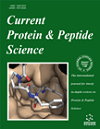- Home
- A-Z Publications
- Current Protein and Peptide Science
- Previous Issues
- Volume 17, Issue 7, 2016
Current Protein and Peptide Science - Volume 17, Issue 7, 2016
Volume 17, Issue 7, 2016
-
-
Functional Role of ADP-Ribosyl-Acceptor Hydrolase 3 in poly(ADPRibose) Polymerase-1 Response to Oxidative Stress
More LessAuthors: Masato Mashimo and Joel MossPoly-ADP-ribosylation has been proposed to be a reversible protein modification, participating in diverse cellular functions including DNA repair, chromatin remodeling, genetic stability, mitosis, and cell death. Poly-ADP-ribosylation is initiated by the transfer of the ADP-ribose moiety of NAD+ primarily to the carboxyl groups of glutamate and aspartate and amino group of lysine residues in target proteins, followed by elongatio Read More
-
-
-
PARG Inhibitors and Functional PARG Inhibition Models
More LessPoly(ADP-ribose) polymerases (PARPs) family proteins catalyze poly(ADP-ribosylation) (PARylation) by conjugating ADP-ribose residues repeatedly on amino acid residues using nicotinamide adenine dinucleotide as a substrate. The inhibitors of PARP widely block DNA repair processes and are currently examined in clinical trials of cancer therapy. Poly(ADP-ribose) glycohydrolase (PARG) is the main nuclear enzyme, which digest Read More
-
-
-
Players in ADP-ribosylation: Readers and Erasers
More LessAuthors: Patricia Verheugd, Mareike Bütepage, Laura Eckei and Bernhard LüscherADP-ribosylation describes an ancient and highly conserved posttranslational modification (PTM) of proteins. Many cellular processes have been identified that are regulated by ADP-ribosylation, including DNA repair, gene transcription and signaling processes. Enzymes catalyzing ADP-ribosylation use NAD+ as a cofactor to transfer ADP-ribose to a substrate under release of nicotinamide. In mammals extracellular and i Read More
-
-
-
New Insights into the Roles of NAD+-Poly(ADP-ribose) Metabolism and Poly(ADP-ribose) Glycohydrolase
More LessAuthors: Sei-ichi Tanuma, Akira Sato, Takahiro Oyama, Atsushi Yoshimori, Hideaki Abe and Fumiaki UchiumiAccumulating evidence has suggested the fundamental functions of NAD+-poly(ADPribose) metabolism in cellular and physiological processes, including energy homeostasis, signal transduction, DNA transaction, genomic stability and cell death or survival. The NAD+ biosynthesis and poly(ADP-ribose) [(ADP-R)n] turnover are tightly controlled by several key enzymes, such as nicotinamide phosphoribosyltransferase (N Read More
-
-
-
Poly(ADP-ribose): Structure, Physicochemical Properties and Quantification In Vivo, with Special Reference to Poly(ADP-ribose) Binding Protein Modules
More LessAuthors: Masanao Miwa, Chieri Ida, Sachiko Yamashita, Masakazu Tanaka and Junichi FujisawaPolyADP-ribosylation is a unique posttranslational modification of proteins, involved in various cellular functions including stability of chromatin. PolyADP-ribosylation modifies acceptor proteins with a large negatively charged poly(ADP-ribose) (PAR) to greatly change the structure and function of the acceptor proteins. In addition various specific motifs of proteins were recently found to interact non-covalently with PAR t Read More
-
-
-
Parp1 Deficiency Confers Defects in Chromatin Surveillance and Remodeling During Reprogramming by Nuclear Transfer
More LessAuthors: Tomoharu Osada, Tadashige Nozaki and Mitsuko MasutaniAccumulating evidence suggests that cloned mice production by the injection of a somatic cell nucleus into an enucleated oocyte is inefficient. DNA damage and chromatin remodeling failures that occur during embryogenesis following nuclear transfer (NT) might explain the poor development of cloned embryos. To avoid these problems, it is important to elucidate somatic chromatin remodeling after NT. Because polyADP-ribosyla Read More
-
-
-
Poly(ADP-Ribose) Polymerases in Aging – Friend or Foe?
More LessAuthors: András Vida, Omar Abdul-Rahman, Edit Mikó, Attila Brunyánszki and Peter BaiPoly(ADP-ribose) polymerases were originally described as DNA repair enzymes. PARP-1, PARP-2 and PARP-3 can be activated by DNA damage and the resulting activation of these enzymes that facilitate DNA repair, seems to be a prerequisite of successful aging. PARP activation helps to maintain genomic integrity through supporting DNA repair systems; however, in parallel these enzymes limit metabolic fitness and make Read More
-
-
-
Plant PARPs, PARGs and PARP-like Proteins
More LessAuthors: Julia P. Vainonen, Alexey Shapiguzov, Aleksia Vaattovaara and Jaakko KangasjärviPoly(ADP-ribos)ylation, originally described as a mechanism of DNA break repair, is now considered as part of a complex regulatory system involved in dynamic reorganization of chromatin structure, transcriptional control of gene expression and regulation of metabolism. In plants poly(ADPribos) ylation has received surprisingly little attention. It has been implicated in abiotic and biotic stress responses, cell cycle co Read More
-
Volumes & issues
-
Volume 26 (2025)
-
Volume 25 (2024)
-
Volume 24 (2023)
-
Volume 23 (2022)
-
Volume 22 (2021)
-
Volume 21 (2020)
-
Volume 20 (2019)
-
Volume 19 (2018)
-
Volume 18 (2017)
-
Volume 17 (2016)
-
Volume 16 (2015)
-
Volume 15 (2014)
-
Volume 14 (2013)
-
Volume 13 (2012)
-
Volume 12 (2011)
-
Volume 11 (2010)
-
Volume 10 (2009)
-
Volume 9 (2008)
-
Volume 8 (2007)
-
Volume 7 (2006)
-
Volume 6 (2005)
-
Volume 5 (2004)
-
Volume 4 (2003)
-
Volume 3 (2002)
-
Volume 2 (2001)
-
Volume 1 (2000)
Most Read This Month
Article
content/journals/cpps
Journal
10
5
false
en


